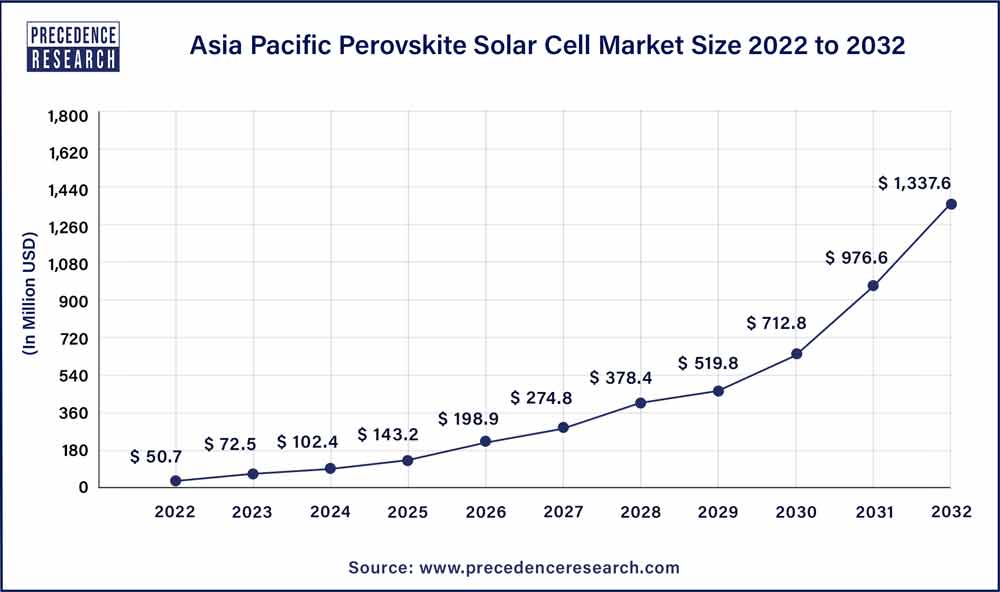Perovskite Solar Cells Lighting Up the Path to a Greener Planet
Perovskite solar cell market size is estimated to grow from USD 94.8 million in 2022 to USD 2,479.2 million by 2032, growing at a double-digit CAGR of 38.1% from 2023 to 2032.
In the quest for sustainable energy solutions, perovskite solar cells have emerged as a beacon of hope, promising to redefine the landscape of solar technology. These innovative cells have captured the imagination of scientists, engineers, and environmentalists alike, presenting a potential game-changer in the race toward a cleaner, greener future.
The perovskite-based solar cells (PSC) industry has a strong chance of expanding throughout the forecast period thanks to rising PSC research and development efforts as well as growing public awareness of the benefits these cells have over silicone photovoltaic technology. A PSC is a type of solar cell that combines superconductivity and magnetic properties with a perovskite-structured substance. Due to the growing use of these solar panels in window panes to turn the absorbed sunlight into power, a sizable demand is anticipated to emerge from smart building applications.
Asia Pacific is poised to expand at a CAGR of 138.2% between 2023 and 2032. Revenue generated by the perovskite solar cell market is likely to reach USD 2,479.2 million by 2032, According to Canada-based organization Precedecne Research.

At the heart of the excitement surrounding perovskite solar cells is their remarkable efficiency in converting sunlight into electricity. Unlike traditional silicon-based solar cells, perovskite cells demonstrate superior light-absorbing capabilities, allowing them to generate more power from the same amount of sunlight. This increased efficiency not only enhances the overall performance of solar panels but also makes renewable energy more accessible and cost-effective.
One of the key advantages of perovskite solar cells lies in their versatility. These cells can be fabricated using simple and cost-effective methods, opening the door to scalable and widespread adoption. The manufacturing process is less energy-intensive compared to conventional solar technologies, making perovskite solar cells a more environmentally friendly choice from both a production and performance standpoint.
Furthermore, perovskite solar cells exhibit a high tolerance to variations in temperature and humidity, addressing common challenges faced by solar technologies in diverse climates. This resilience makes them an attractive option for regions with extreme weather conditions, expanding the geographical reach of solar energy and making it a viable solution for a broader range of applications.
The potential applications of perovskite solar cells extend beyond traditional solar panels. Researchers are exploring innovative uses such as transparent solar windows, enabling buildings to harness solar energy without sacrificing natural light. This integration of solar technology into everyday infrastructure represents a significant step towards sustainable urban development.
However, challenges remain on the path to widespread adoption of perovskite solar cells. Stability and durability issues, especially in outdoor conditions, require further research and development. Additionally, addressing concerns related to the toxicity of certain perovskite materials is crucial to ensure the environmental sustainability of these technologies.
As research and development efforts continue, the future of perovskite solar cells appears promising. Their potential to revolutionize the solar energy landscape, coupled with their affordability and adaptability, positions them as a leading contender in the global shift towards renewable energy sources. With each technological advancement, perovskite solar cells are lighting up the path to a greener and more sustainable planet.
The increasing demand for solar energy due to its versatility and low weight is one of the main factors driving the amorphous solar cell sector. The market also gains from the increase in applications from various industries. The market is expanding more quickly as a result of stable energy prices and increased economic activity. The sector has expanded as a result of the growing need to employ present energy resources to fight poverty and improve quality of life. The increase in solar systems affects the market as well. Due to the increased need for perovskite cells and the consequent need to reduce the price of solar cell panels, the market is expanding.
Additionally, the perovskite solar cells market has benefited from changes in lifestyle, improved investments, expanding urbanization, and rising consumer spending. Perovskite-based solar panels are easier to obtain, more affordable, and easier to build than conventional energy panels. High performance is achieved by the amazing power conversion that these cells offer. These qualities are projected to greatly enhance the perovskite-based solar electricity market due to their growing adoption.
Perovskite solar cells have a very high growth potential in the coming years because of their substantial temperature dependency and magnetic properties. In comparison to conventional storage photovoltaics, these devices also offer several additional advantages, such as the ability to react to different light wavelengths that are absorbed by the panels. They are also flexible and light, which will probably lead to an increase in demand for them in the upcoming years.
The increase in R&D activities opens up profitable opportunities for market participants. The market will expand even further as more people start using alternative forms of energy.
Recent Developments:
➢ In August 2019, Meyer Burger, a Swiss engineering firm, sold the first piece of solar cell production equipment to Oxford PV, a UK-based perovskite specialized business. Oxford PV hopes to build a 250 MW perovskite special assembly plant through this acquisition by the end of 2020.
➢ Saule Technologies formally unveiled an industrial assembly line of inkjet-printed solar cells using perovskite in February 2019 on a test basis. By the end of 2020, the company hopes to have constructed 180,000 sq m of solar cells.
Structure of Perovskite Solar Cells:

Initiating at Step 1: The substrate for the perovskite device's photoanode manifests as Fluorine-doped Tin Oxide (FTO)/Indium-doped Tin Oxide (ITO) coated glass.
Proceeding to Step 2: A dense layer of semiconducting material, predominantly TiO2, assumes the role of a hole-blocking or compact layer. Typically deposited through spin-coating or spray-coating atop the FTO substrate, it prevents the holes, extracted by the electron-selective layer above, from interfacing with the FTO/ITO glass, thereby thwarting recombination losses.
Advancing to Step 3: The Electron Transport Layer (ETL) facilitates the diffusion of electrons from the photoexcited perovskite layer into the FTO/ITO glass, subsequently directing them into the external circuit.
Navigating to Step 4: The perovskite layer, functioning primarily as a sensitizer, is spin-coated atop the electron-transporting layer. While versatile in its capabilities as a sensitizer, absorber, or electron/hole transporter, its central role lies in sensitization.
Moving on to Step 5: The adjacent hole transport layer permits the movement of holes generated by the excited perovskite towards the metallic cathode, facilitating extraction.
Concluding at Step 6: A metallic contact layer, often deposited through thermal vaporization, assumes the role of the counter electrode, also known as the back contact, completing the solar cell's structure.
Segmentation of Perovskite Solar Cell as below;
By Structure: Planar Perovskite Solar Cells and Mesoporous Perovskite Solar Cells
By Product: Rigid Perovskite Solar Cells and Flexible Perovskite Solar Cells
By Method: Solution Method, Vapor-Assisted Solution Method, and Vapor-Deposition Method
By Application: Smart Glass, Perovskite in Tandem Solar Cells, Solar Panel, Portable Devices, Utilities, and BIPV (Building-Integrated Photovoltaics)
By End-Use: Manufacturing, Energy, Aerospace, Industrial Automation, Consumer Electronics, and Others
By Type: Flexible PSCs, Hybrid PSCs, and Multi-Junction PSCs
To know detailed insights on the above segments, Click Here
Featured Product

Southco Inc. - POWER UP YOUR CHARGING DESIGN
With engineered access solutions for electric vehicle charging equipment. Southco's engineered access hardware, including locks, latches and hinges can help Electric Vehicle (EV) charging manufactures to achieve high standards of equipment performance, usability and security, providing a seamless charging experience for drivers.
